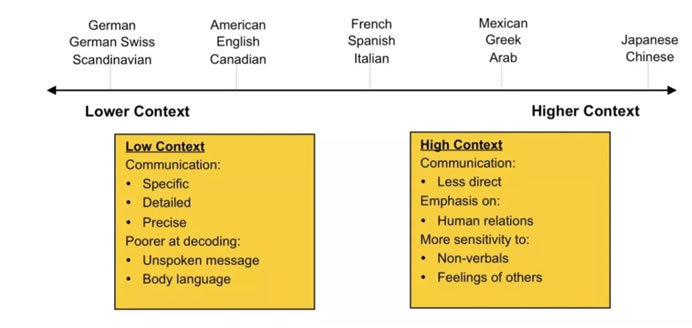Internationalisation - Cultural Issues and Buying Behaviour (Part 1)
Published by DIFME on 23-Mar-2020
Cultural Issues and Buying Behaviour (Part 1)

The world is becoming more globalised, and research indicates that the drastic differences between cultures, clearly effects consumer behaviour. In order to achieve customer satisfaction, businesses must therefore recognize these differences. Furthermore, if an entity is looking into internationalising, enterprises must develop marketing communications that respond to both domestic and global perspective.
Culture and buying behaviour are found to be related in an unprecedented way, Consumer behaviour is largely determined by cultural factors comprised of mutually shared assumptions, norms, values and standards of a specific culture. Marketers and other experts have noted the increasing importance for further insight of the relationship between consumers and markets around the globe. Studies have revealed patterns between culture and consumer behaviour, between different ethnic groups and subgroups that contain similar cultural values Researchers have found differences across subcultures in aspects such as brand loyalty, perceived risk and decision making Cultural factors differ among countries, but they become complicated when people immigrate to other countries with different cultural understandings.
Culture
Culture is defined by the beliefs, values and customs that serve to guide the consumer behaviour of members of a society. Those beliefs and values refer to the acquired feeling and priorities that individuals have about their things and possessions -the culture is based on languages, education, laws, economy, religion, class, values, status, food customs, art, technology, manners and work pattern, shared in a specific society. Cultural influence change under political, social, technological and economic forces, which makes it so dynamic and complex, that is often difficult to determine its impact on human behaviour. The influence of culture on contemporary consumers varies between countries, it is also affected by an individual`s family, friends and social environment during his whole life.
For instance, in some countries they value the German made products, in other they prefer Swedish cars; in different societies people eat pasta solely as a main dish whilst in others it is considered as a side dish. In some they even add pasta to baked beans. Some cultures eat pasta with a spoon and fork, in other cultures this is unacceptable. Some cultures cannot appreciate espresso coffee and only opt for instant coffee which has been coined as 'Americano' . Some cultures add potato chips to their pizza as a topping whilst other cultures think this in very bad taste .. In France men use more cosmetic products than women. In Japan the number four is considered unlucky, and more products are sold in groups of five. These are all examples of the behaviour of different societies.
Cultures could also be analyzed basing on their communication types. Hall (1966) have proposed two types of countries:
High context (for example Asia, Arabic countries). For consumers from these countries, the communication is influenced by close human relationships, a clearly structured social hierarchy, and strong norms of behaviour.
Consumers from low-context countries (e.g. Germany, France, Great Britain, USA) aim to say as much as possible directly, the linear and open and clear communication is dominated.

One important instrument, the World Value Survey (WVS), assesses peoples’ values and beliefs. The WVS has over the years demonstrated that people’s beliefs play a key role in economic development, the emergence and flourishing of democratic institutions, the rise of gender equality, and the extent to which societies have effective government.
Have a look at the site worldvaluesurvey.org
Subculture A society with a common culture can be subdivided into various groups called sub-cultures. Subcultures are groups of people who share the same values and behaviour due to a common lifestyle or similar experience .They can be divided on the basis of socio cultural-nationalities- religion, racial groups; and demographics-language, gender, age. The sub-cultures differences in consumer behaviour can be used by marketers to segment the market activity and adapt the promotional activities, positioning, marketing mix and brand name. Below are described some important categories of subcultures on the basis of nationality, economic situation, religion, age, race, age and gender.
Nationality subculture Many countries are divided in sub cultures. Within a particular countries there are vast amount of population who have origins from other countries, with each region having its hereditary characteristics. In India for example, there are Indians, Sikh’s, Indo Chinese, Punjabi’s, Parsees, Moghuls and South Indian people .These people show different consumer behaviour in dressing style, foods, language, cultural artefacts etc.
Age is a major subculture. The consumers’ habits, lifestyle, activities and hobbies evolve with the time. There are different stages that are considered to be distinctive – young people, married couples, single people, and elderly people. Different age groups have different preferences for music, magazines, foods, TV programs, movies, clothes etc. For instance, young people are more exposed to unhealthy products like fast food, in contrast to elderly people who need to have healthy diet in order to avoid health problems The factors influencing the buying decision process change according to the individual status- whether he is single, in a relationship, if he has children. They also change according to the region where an individual lives- in a city, in small town or in the countryside. Marketers should evaluate and measure the criteria that influence the buying behaviour in order to adapt to their customers.
Education level varies considerably between countries. One powerful indicator of education is a country illiteracy level. You can find the rates here.
In countries with low literacy levels, marketers needs to exercise caution in matters such as product labelling, print ads and survey research. Companies should be also concerned about the quality of education. PISA is a study conducted by OECD every 3 years that assesses skills in reading, science and mathematics. There are even some huge differences even in countries with similar level of economic development. See here.
Also the digital skills of the foreign country consumers and potential employees are urgent. These skills involve the confident and critical use of information society technology (IST) for work, leisure, learning and communication. It is underpinned by basic skills in ICT: the use of computers to retrieve, access, store, produce, present and exchange information, and to communicate and participate in collaborative networks via the Internet. The rates of digital skills among Europe population is presented below (see more on this analysis here).
Social class Consumer economic situation or social class has maybe the biggest influence on the consumer behaviour of an individual. If a consumer has low income he will be more focused on price, while a person who belongs to a higher social class is interested in elements such as features and quality. Social class influences buying preferences in many aspects-clothing, entertainment, furnishing, what a person drives or rides, which product or brand he needs or does not needs. Some brands are focused only to one social class. Others, like BMW, adjust their products to match different classes (Normal, Premium and Super Premium cars) (Bhasin, 2016). The buying behaviour of people in certain social class is similar, and it is important for a business to adjust their marketing activities to them and invest in understanding the local culture.
Gender All cultures have inherited different traits for males and females roles. However in the modern world the roles are slowly getting mixed and both genders perform the other`s traditional roles. Studies have revealed that genders react differently to advertisements. Women are influenced more by complex, category oriented ads, while men are affected more by simple attribute oriented ads. Marketers should analyze these preferences and advertise differently for men and women. The role of women in society is sometimes largely driven by local religion. In Islam societies, conducting market research that involves women is extremely difficult.
Religion plays a vital role in many societies. In every country around the world people belong to different religions, have different faiths and beliefs, like Christians, Muslims, Buddhist etc. For example, it is against Hindu culture for a bride to wear red on her wedding, for a Christian bride it is preferable to wear a white dress, and Muslims prefer wearing green on this occasions. For Muslims eating pork is against the Muslim religion, and for Hindus eating beef is considered to be a sin. Even with the same culture, these subcultures show distinctive purchasing behaviours.
In India the belief in karma causes consumers to set higher expectations on the quality of a product or service. In Asian countries, the philosophy of feng shui (wind water) plays an important role in design and placement of corporate buildings and retail spaces.
Religious norms can also influence advertising campaigns. Religion also shapes the holiday calendar in many countries and often steer advertising campaigns or may open up untapped market opportunities..For example, in many Muslim countries Coca-cola also decorates Coke cans with a crescent moon and star, well-recognized symbols in Islam, to celebrate Ramadan.
Further reading
Cultural problems encountered multinational companies
When does culture matter marketing
Cultural factors influence customer behavior McDonalds marketing strategies
